MForum.ru
31.01.2005, MForum.ru
Airat Gumerov, CBOSS Development Division, CBOSS Association, Report at the 6th annual CBOSS User Group in Abu-Dhabi, November 2004, recorded by MForum.ru
Overview of content tariffs employed by world’s leading mobile operators. Content billing for mobile operators. Standard Internet services. Trends in 2.5/3G network billing.
Tariffs Used by World’s Leading Mobile Operators
Study of tariffs offered by leading operators in Europe and USA singles out several basic approaches to service rating. They are listed below in order of frequency:
The information above is summarized in the following table
| Tariff | IP Services | Market | Example |
| Postpaid Usage-based Unified |
Internet access Mobile content |
Corporate customers | Europe: O2, T-Mobile, Vodafone |
| Postpaid Usage-based Flexible |
Internet access Mobile content |
Individual customers | Europe: O2, T-Mobile, Vodafone |
| Postpaid Event-based Flexible |
Mobile content |
Individual customers Corporate customers |
Europe: O2, T-Mobile, Vodafone |
| Postpaid Unlimited Flexible |
Internet access Mobile content |
Individual customers | USA: T-Mobile |
| Prepaid Usage-based Flexible |
Internet access Mobile content |
Individual customers | Europe: T-Mobile |
| Postpaid/prepaid Duration-based Uinfied |
Internet access Mobile content |
WLAN users | Europe: A1 |
Classic Internet Services for Mobile Customers
The study shows that both postpaid and prepaid mobile operators tend to use simpler tariffs than their Internet counterparts. Still the question arises whether it is possible to apply flexible tariffs and zone-based rating to telematic services (access to e-mail and game servers) offered by LAN operators, xDSL and home network providers? The answer is “Yes!”
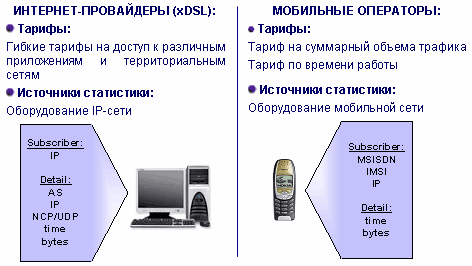
The main drawback of this technology is that mobile subscribers are not assigned static IP addresses in the network; therefore, it requires additional resources to identify network traffic. You can very well allot IP addresses, but supporting them eventually turns out to be quite expensive. The solution is to correlate mobile (MSISDN, IMSI) and IP network data. The picture below shows how to achieve this. In this system traffic is identified by zone or by application. Equipped with such tools, operators can introduce specific tariffs that would individually cover gaming, mail services, etc.
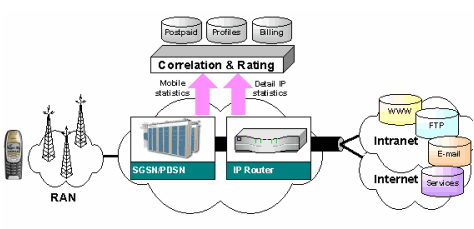
CBOSSip is based on that principle. The solution aggregates details based on analyzed correlation between RADIUS statistics from GGSN/PDSN and Netflow statistics from routers. As a result, mobile operators benefit from the following:
Postpaid volume-based rating
Zone-based tariffs
Statistics details can be stored for further use
Therefore, the solution’s advantages are the following:
Static and dynamic IP addresses;
Support of standard features and telecommunication protocols employed by telecommunication equipment.
Modern Approaches to Data Service Rating in 2.5G/3G
Success of any service promotion is directly dependent on flexibility of offered tariffs. In packet data networks where multiple sessions are simultaneously executed via a single customer terminal, rating efficiency and speed requirements are soaring.
Presently, there are two main approaches to build prepaid billing solutions for data transmission service in 2.5G/3G networks.
The first one focuses on the mobile network telecommunication equipment that supports standard protocols (e.g., CAMEL3), the second - implies the use of IP network gateways.
The first approach addresses the main task – packet data transmission in the Prepaid scheme - and supports roaming and various value-added services (SMS, EMS, MMS, USSD). However, if this is a preferred option, the operator is unable to make use of flexible rating or rating by zone and by content. Besides, CAMEL3 is not that simple to obtain and it is usually rather expensive.

In the Proxy gateway technology the traffic is routed via allocated servers. Consequently, rating covers all the traffic both ways (from/to the subscriber). The option is most suitable for data transmission services and allows further extending the set of offered services and introducing content-based services. However, the downsides of the scheme – degraded system performance and scalability, as well as features to align supported standards to a single rating pattern, should not be overlooked.
The results are specified in the table below.
| Camel III | Proxy | |
| Deployment Requirements | Camel Phase III support | High performance Proxy Gateway |
| Roaming Support | Enabled | Can be implemented on IN platform |
| Support of special rating protocols (SMS, MMS, USSD, etc.) | Enabled | Restricted |
| Traffic differentiation | Disabled | Enabled |
| Content rating differentiation | Disabled | Enabled |
| Application field | GSM | GSM, CDMA, Wi-Fi, etc. |
| Implementation costs | Expensive | Cost-effective |
We should stress that the specified options are not necessarily to be used cooperatively, but are rather to complement each other. The operator opts for the technology that better suits customer demands and technical equipment parameters.
Content Billing Implementation by Mobile Operators
Content-based services are a promising innovation, which allows the mobile operator to enter into a lucrative segment of the market. Subscribers, too, capitalize on anonymous and transparent access to premium resources with automatic account debiting. Let’s dwell upon how content-based services are implemented and what schemes are used to interact with the content provider.
The easiest solution is, apparently, to sale content based on traffic cost. In this case, with little modification to current networks and billing infrastructures, mobile operators raise their profits and boost the use of basic data services.
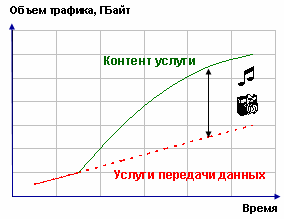
This approach addresses the central issue - transparent subscriber authorization. The range of IP addresses for which password authorization should be disabled is disclosed to the content provider. It is obvious, that the scheme is good for cheap content with approximately equal ratio of unit price and traffic volume. That is seen as the main limitation of the scheme.
Characteristics:
Anonymous access to content resources.
Charging associated traffic only.
Advantages:
Profits increased through extended use of basic services
Current infrastructure employed.
No specific requirements.
Transparent settlement scheme.
Disadvantages:
Can be applied only to cheap content with approximately equal ratio of unit price and traffic volume.
Volume-based rating, apparently, will for long remain an accounting scheme of choice, especially for large volume content (DVD films), since it allows content delivery via low bandwidth channels using various downloading tools. Nevertheless, usage-based rating seems to be more complex than other methods, e.g., small volume content (mp3, mobile game, books) is charged per event, streaming content (TV-and-radio broadcast via the Internet) using time-based rating.
Rating Types and Their Application Areas
Subscription: information web sites (news, jokes, ratings, etc.)
Event-based: small volume content (mp3, games, post cards, images)
Time-based: streaming content (Internet TV/radio)
Volume-based: non-streaming, large volume content (DVD files, ZIP archives…)
Presently, there are two main approaches to enhance flexibility in content rating: the first one – specified earlier in this report - is to use Proxy gateways, the second – to delegate both controlling and accounting to the service provider.
Let’s consider the both approaches in terms of content rating.
Proxy Gateways
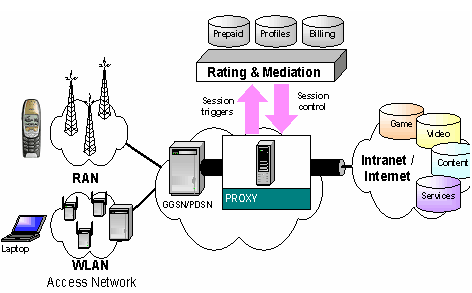
Characteristics
IP stream identification and classification.
Content identification.
Rating event generation.
Session management.
Advantages:
Prepaid rating of IP traffic and content
Flexible IP content and traffic rating
Double rating (traffic and content) eliminated
Diverse network access technologies
Disadvantages:
Not applicable for accounting specialized applications
Not applicable for encrypted communications channels
Additionally to the content rating, the first approach provides flexible Prepaid rating for data services. Besides, only this scheme cures double charging (for the content and associated traffic, including collateral and advertising information that is usually featured during the content sale).
However, Proxy Gateways can hardly be used to account complicated business transactions operated by specialized applications, e.g., in mobile commerce.
Another way to address the issue, as it was specified earlier in this report, is to delegate control and accounting to the content provider. This implies the provider would interact with the billing system via the standard protocol.
Provider’s Content Accounting Scheme
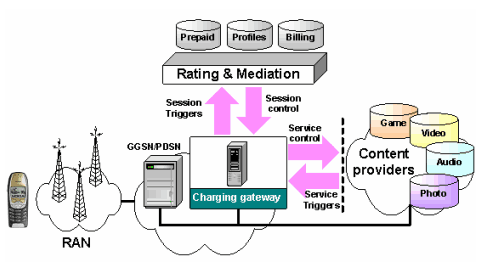
Advantages
The content provider is encouraged to lead an independent tariff policy
Special content transmission protocols are supported
Capability to transmit content via encrypted channels is enabled
Disadvantages
Double charging (Double charging for content and traffic)
Not applicable for streaming services and large volumes
Therefore, it is obvious that each of the specified solutions has certain disadvantages along with advantages. At the same time, the options do not overlap functionally and should be considered not as alternatives, but complementary to each other. CBOSS Association favors every approach its clients may accept and is willing to assist in practically meeting their needs.
© Airat Gumerov, CBOSS
© Edited by Alexey Boyko, Mobile Forum
24.10. [Новинки] Анонсы: Redmi K90 – новый «доступный флагман» представлен в Китае / MForum.ru
24.10. [Новинки] Анонсы: Redmi K90 Pro Max на базе Snapdragon 8 Elite Gen 5 представлен официально / MForum.ru
23.10. [Новинки] Анонсы: Nubia Z80 Ultra с новой 35 мм камерой представлен официально / MForum.ru
22.10. [Новинки] Анонсы: Realme GT8 представлен официально / MForum.ru
22.10. [Новинки] Анонсы: Realme GT8 Pro – смартфон со сменным обрамлением камер и топовыми характеристиками / MForum.ru
21.10. [Новинки] Анонсы: В Китае представлен планшет iQOO Pad 5e / MForum.ru
21.10. [Новинки] Анонсы: Флагманский смартфон iQOO 15 с Snapdragon 8 Elite Gen 5 представлен официально / MForum.ru
20.10. [Новинки] Анонсы: Планшет Oppo Pad 5 и смарт-часы Watch S представлены официально / MForum.ru
20.10. [Новинки] Анонсы: Представлены Oppo Find X9 и X9 Pro на базе чипсета Dimensity 9500 / MForum.ru
20.10. [Новинки] Анонсы: Складной смартфон Huawei Nova Flip S представлен официально / MForum.ru
17.10. [Новинки] Анонсы: Роскошный смартфон Vertu Agent Q можно будет купить только в одном магазине / MForum.ru
16.10. [Новинки] Анонсы: Honor официально представила Magic 8 и Magic 8 Pro / MForum.ru
16.10. [Новинки] Анонсы: Honor Watch 5 Pro представлены официально / MForum.ru
16.10. [Новинки] Анонсы: Honor MagicPad3 Pro 13.3 представлен официально / MForum.ru
16.10. [Новинки] Анонсы: «Новый» Moto G100 с аккумулятором 7000 мАч представлен официально / MForum.ru
15.10. [Новинки] Анонсы: Vivo TWS 5 – флагманские наушники с 11 мм динамиками и Hi-Fi версией / MForum.ru
15.10. [Новинки] Анонсы: Vivo Watch GT 2 с ярким дисплеем и eSIM представлены официально / MForum.ru
14.10. [Новинки] Анонсы: Планшет Vivo Pad 5e представлен официально / MForum.ru
14.10. [Новинки] Анонсы: Vivo X300 и X300 Pro с 200 Мп камерами представлены официально / MForum.ru
14.10. [Новинки] ![]() Анонсы: Характеристики Honor Magic 8 Pro раскрыты до анонса / MForum.ru
Анонсы: Характеристики Honor Magic 8 Pro раскрыты до анонса / MForum.ru